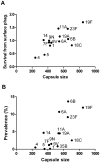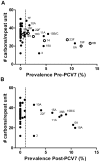Pneumococcal capsular polysaccharide structure predicts serotype prevalence
- PMID: 19521509
- PMCID: PMC2689349
- DOI: 10.1371/journal.ppat.1000476
Pneumococcal capsular polysaccharide structure predicts serotype prevalence
Abstract
There are 91 known capsular serotypes of Streptococcus pneumoniae. The nasopharyngeal carriage prevalence of particular serotypes is relatively stable worldwide, but the host and bacterial factors that maintain these patterns are poorly understood. Given the possibility of serotype replacement following vaccination against seven clinically important serotypes, it is increasingly important to understand these factors. We hypothesized that the biochemical structure of the capsular polysaccharides could influence the degree of encapsulation of different serotypes, their susceptibility to killing by neutrophils, and ultimately their success during nasopharyngeal carriage. We sought to measure biological differences among capsular serotypes that may account for epidemiological patterns. Using an in vitro assay with both isogenic capsule-switch variants and clinical carriage isolates, we found an association between increased carriage prevalence and resistance to non-opsonic neutrophil-mediated killing, and serotypes that were resistant to neutrophil-mediated killing tended to be more heavily encapsulated, as determined by FITC-dextran exclusion. Next, we identified a link between polysaccharide structure and carriage prevalence. Significantly, non-vaccine serotypes that have become common in vaccinated populations tend to be those with fewer carbons per repeat unit and low energy expended per repeat unit, suggesting a novel biological principle to explain patterns of serotype replacement. More prevalent serotypes are more heavily encapsulated and more resistant to neutrophil-mediated killing, and these phenotypes are associated with the structure of the capsular polysaccharide, suggesting a direct relationship between polysaccharide biochemistry and the success of a serotype during nasopharyngeal carriage and potentially providing a method for predicting serotype replacement.
Conflict of interest statement
The authors have declared that no competing interests exist.
Figures




References
-
- Bogaert D, de Groot R, Hermans PWM. Streptococcus pneumoniae colonisation: the key to pneumococcal disease. Lancet Infect Dis. 2004;4:144–154. - PubMed
-
- Babl F, Pelton S, Theodore S, Klein J. Constancy of Distribution of Serogroups of Invasive Pneumococcal Isolates Among Children: Experience during 4 Decades. Clin Infect Dis. 2001;32:1155–1161. - PubMed
-
- Hausdorff William P, Bryant J, Paradiso Peter R, Siber George R. Which Pneumococcal Serogroups Cause the Most Invasive Disease: Implications for Conjugate Vaccine Formulation and Use, Part I. Clin Infect Dis. 2000;30:100–121. - PubMed
-
- Hausdorff WP, Feikin DR, Klugman KP. Epidemiological differences among pneumococcal serotypes. Lancet Infect Dis. 2005;5:83–93. - PubMed
-
- Brueggemann A, Griffiths D, Meats E, Peto T, Crook D, et al. Clonal Relationships between Invasive and Carriage Streptococcus pneumoniae and Serotype and Clone Specific Differences in Invasive Disease Potential. J Infect Dis. 2003;187:1424–1432. - PubMed
Publication types
MeSH terms
Substances
Grants and funding
LinkOut - more resources
Full Text Sources
Medical

